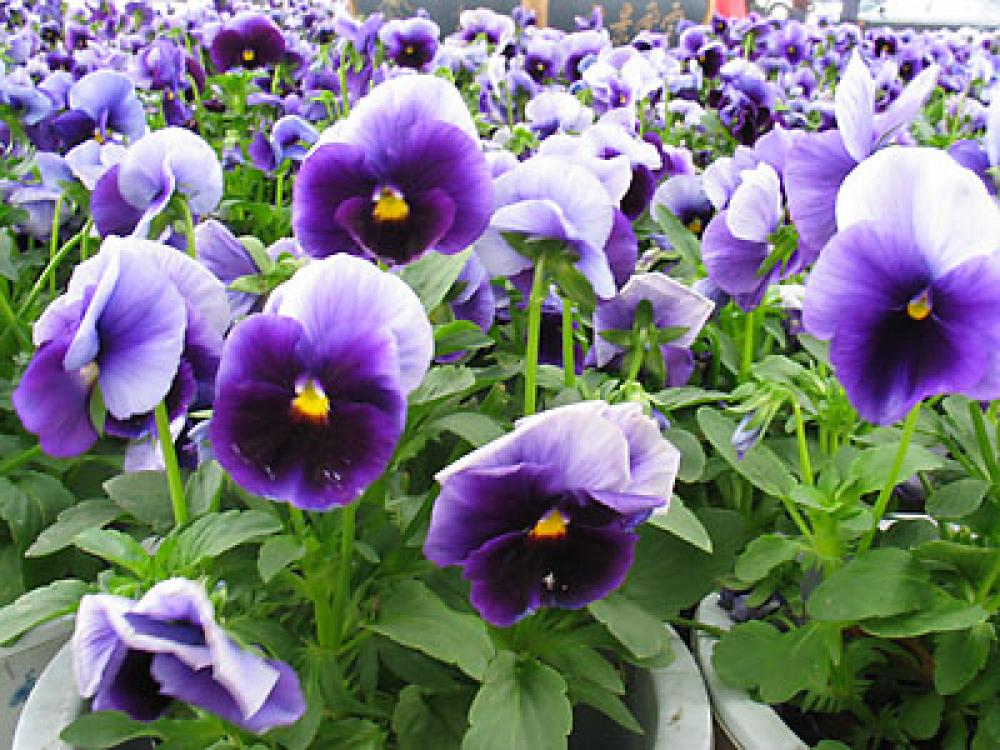



Scientific classification
Kingdom: Plantae
(unranked): Angiosperms
(unranked): Eudicots
(unranked): Rosids
Order: Malpighiales
Family: Violaceae
Genus: Viola
Section: Viola section Melanium
Species: V. tricolor
Subspecies: V. t. var. hortensis
Trinomial name: Viola tricolor var. hortensis DC.
Names and terminology
English common names, such as "pansy", "viola" and "violet" may be used interchangeably. One possible distinction is that plants considered to be "pansies" are classified in Viola sect. Melanium, and have four petals pointing upwards (the two side petals point upwards), and only one pointing down, whereas those considered to be "violets" are classified in Viola sect. Viola, and have two petals pointing up and three pointing down. Another possible distinction is made by the American Violet Society – the International Cultivar Registration Authority for the genus Viola. It divides cultivated varieties (cultivars) in Viola sect. Melanium into four subgroups: B1 – pansies, B2 – violas, B3 – violettas and B4 – cornuta hybrids. On this classification, modern "pansies" differ from the other three subgroups by possessing a well-defined "blotch" or "eye" in the middle of the flower.
Modern horticulturalists tend to use the term "pansy" for those multi-coloured large-flowered hybrids that are grown for bedding purposes every year, while "viola" is usually reserved for smaller, more delicate annuals and perennials.
Pests and diseases
Aphids
Aphids, which can spread the cucumber mosaic virus, sometimes feed on pansies. Infestations are treated with a spray of diluted soft soap (2 ounces per gallon) or insecticides.
Leaf spot
Leaf spot (Ramularia deflectens) is a fungal infection. Symptoms include dark spots on leaf margins followed by a white web covering the leaves. It is associated with cool damp springs.
Downy mildew
Pansy downy mildew is caused by the fungus-like organism Peronospora violae, which produces purple-brown leaf spots, often with encircling yellowing, that have an accompanying grey mold on the leaf underside. It can severely weaken or kill affected plants.
Powdery mildew
A disease caused by one or more species of fungus in the Erysiphaceae family.[16] Symptoms include violet-gray powder on fringes and underside of leaves. It is caused by stagnant air and can be limited but not necessarily eliminated by spraying (especially leaf undersides).
Slugs and snails
Slugs and snails feed on the foliage. Sometimes sharp, gritty sand or a top-dressing of chipped bark is used by gardeners to limit damage.
Stem rot
Stem rot, also known as pansy sickness, is a soil-borne fungus and a possible hazard with unsterilized animal manure. The plant may collapse without warning in the middle of the season. The foliage will flag and lose color. Flowers will fade and shrivel prematurely. Stem will snap at the soil line if tugged slightly. The plant is probably a total loss unless tufted. The treatment of stem rot includes the use of fungicides such as Cheshunt or Benomyl, which are used prior to planting. Infected plants are destroyed (burned) to prevent the spread of the pathogen to other plants.
Cucumber mosaic virus
The cucumber mosaic virus is transmitted by aphids. Pansies with the virus have fine yellow veining on young leaves, stunted growth and anomalous flowers. The virus can lay dormant, affect the entire plant and be passed to next generations and to other species. Prevention is key: purchases should consist entirely of healthy plants, and pH-balanced soil should be used which is neither too damp nor too dry. The soil should have balanced amounts of nitrogen, phosphate and potash. Other diseases which may weaken the plant should be eliminated.
Phone 02-2826835, 02-2975831, 083-1232647
Fax. 02-2826835, 02-2820620
Phone.Army. 95831
Fax.Army. 91635